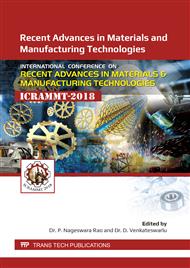p.738
p.744
p.750
p.756
p.762
p.768
p.775
p.781
p.787
Investigation of the Impact of Cutting Parameters on Surface Integrity in the End Milling of Inconel 625
Abstract:
Nickel based super alloys, such as Inconel 625 is amongst the most difficult to machine, due to its low thermal conductivity and high strength at higher temperature. Although, they are used in aerospace exhaust systems and other applications, the strain hardening that results during the machining operation, which adversely affects surface integrity of machined surface of such materials especially in extensive applications, is a cause for concern. In this context, this study was carried out, involving the milling operation, using solid carbide tools coated with TiAlSiN, under specifically developed conditions for dry machining of the difficult to cut materials. The cutting parameters were 4 in number, namely radial rake angle, feed per tooth, cutting speed and radial depth of cut and the response parameters included surface integrity characteristics, such as residual stresses, surface roughness and micro-hardness. Based on the experimental analyses, it was found that the micro-hardness of machined surface was higher. Micro hardness of sub surface decreases with the depth (50,100,150,250μm) due to a reduction in the work hardening of the Inconel 625, underneath the surface layer. The residual stresses were analyzed using main effect plot, and it was seen that the residual stresses were significantly influenced by the radial rake angle, followed by feed per tooth.
Info:
Periodical:
Pages:
762-767
Citation:
Online since:
August 2019
Authors:
Price:
Сopyright:
© 2019 Trans Tech Publications Ltd. All Rights Reserved
Share:
Citation:



